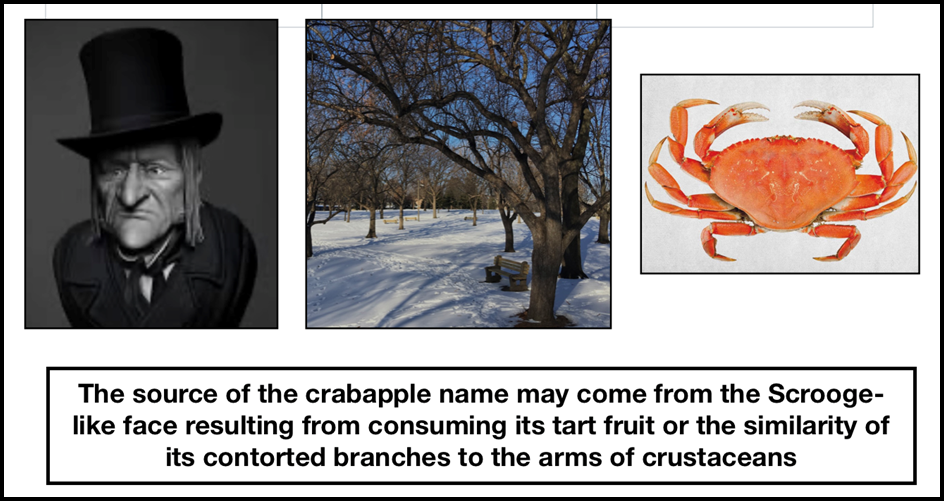By Ken Johnson
“Indeed, it is in this sense the most civilized of all trees.
It is as harmless as a dove, as beautiful as flocks and herds.”
-Theophrastus, Greek philosopher,
often considered the father of botany, circa 371-287 BCE
 One of the great treasures of the Bernheim Arboretum is its outstanding Crabapple Collection. This collection greets everyone who visits with its astonishing beauty, just a few short yards inside the entrance. The collection is among Bernheim’s earliest, dating back to the 1930s and 1940s, though most planting records for that period were destroyed when the original Bernheim headquarters building burned down. Few, if any, of the original trees likely remain. Some trees have fallen victim to high winds and other severe weather, others succumbed to disease, and still others reached the end of their normal lifespan of 40-60 years.
One of the great treasures of the Bernheim Arboretum is its outstanding Crabapple Collection. This collection greets everyone who visits with its astonishing beauty, just a few short yards inside the entrance. The collection is among Bernheim’s earliest, dating back to the 1930s and 1940s, though most planting records for that period were destroyed when the original Bernheim headquarters building burned down. Few, if any, of the original trees likely remain. Some trees have fallen victim to high winds and other severe weather, others succumbed to disease, and still others reached the end of their normal lifespan of 40-60 years.
Additional crabapple trees were added in the 1950’s and the following decades. Many were donated to Bernheim by nurseries in Illinois, Indiana, and Ohio, as well as the National Arboretum in Washington, D.C. Unfortunately, a number of diseases affect crabapples including apple scab, fire blight, and cedar apple rust. Fungicides are available and can be effective, but Bernheim avoids the use of these chemicals due to their impact on our environment. The horticulture team now plants trees that are believed to be disease resistant and they are closely monitored.
 Defining crabapples presents challenges. All apples are in the Rosaceae family along with roses, almonds, pears, apricots, hawthorns, serviceberries, and many others. Crabapples are in the genus Malus which they share with apples having larger fruit, commonly called orchard apples. In the Malus genus, there are over 50 species of apples worldwide, and nearly all are considered to be crabapples. The widely accepted definition of a crabapple is a member of the Malus genus that produces fruit no more than 2” in diameter – most crabapples are well under that size.
Defining crabapples presents challenges. All apples are in the Rosaceae family along with roses, almonds, pears, apricots, hawthorns, serviceberries, and many others. Crabapples are in the genus Malus which they share with apples having larger fruit, commonly called orchard apples. In the Malus genus, there are over 50 species of apples worldwide, and nearly all are considered to be crabapples. The widely accepted definition of a crabapple is a member of the Malus genus that produces fruit no more than 2” in diameter – most crabapples are well under that size.

Crabapples and their larger siblings, the orchard apples, and many other fruit trees including pears, peaches, and apricots do not grow true to seed. Their offspring are usually quite different from the parent tree. Apple trees must be grown from scions, the young shoots or twigs taken from a desired tree, and then grafted onto dependable apple rootstock, to ensure a desired outcome. If you plant the seeds of any of these trees you almost invariably will get a tree variety that produces very different fruit from the parent tree. For example, all Honeycrisp apples sold are produced from trees that are clones derived from a single tree grown by the Minnesota Agricultural Experiment Station in 1974. Planting their seeds will not result in a Honeycrisp tree, or likely any other tree that produces desirable fruit.

John Chapman, commonly known as Johnny Appleseed, planted his apple seeds throughout a large part of the eastern US and Canada. The art of grafting had been well known for thousands of years but it appears that Mr. Chapman rejected that technique for religious reasons and, though he was believed to be a teetotaler, he inadvertently propagated crabapple trees best suited for producing hard cider. There are four crabapple species native to the United States. None of these species are commonly found in Kentucky, though isolated populations of three species– the southern crabapple (Malus augustifolia), the sweet crabapple (Malus coronaria), and the prairie crabapple (Malus ioensis)– might be found.
Crabapple trees were a source of food and sometimes medicinal products for many Native American populations. They provide numerous benefits to the environment– their flowers provide nectar and are pollinated by several species of bees including honey bees and bumble bees. As some varieties of orchard apples are not self-pollinating and require another nearby apple tree to provide the pollen needed to produce fruit, crabapples are often planted in apple orchards for that purpose. Crabapples are host plants for a wide variety of butterflies and moths. The fruit is a favored food source for many animals including black bears, deer, turkeys, squirrels, and numerous insects.
Currently, there are over 1,000 horticultural varieties of crabapples with more being added to the market every year. Nurseries seek to develop varieties that are disease resistant, hardy, and have an abundance of long-lasting flowers with attractive colors– white, pink, purple, and red are all available. Unlike their larger siblings, the orchard apples, crabapple varieties are seldom developed for the quality of their fruit. Some varieties such as “Spring Snow” and “Prairie Rose” produce abundant flowers but no fruit at all.
Despite their usual tart taste, crabapples are safe to eat. A widely believed misconception is that the seeds are very dangerous to consume. The seeds do contain cyanogenic glycoside which our bodies can metabolize into poisonous cyanide. However, you would need to not only consume a very large number of seeds but would also need to chew them (otherwise the seeds would just pass through the body intact) to suffer any ill effects. Still, there is no reason to purposely consume the seeds. The petals of the crabapple flower are also edible and can brighten up a salad or other dish. Always be certain that you are not using any part of a tree that has been sprayed with chemicals.
Relatively few commercial products are made from crabapples. Along with beverages, crabapple preserves are available. There are also many recipes available in cookbooks and online for using crabapples in various dishes such as pies, tarts, and other pastries. Crabapple lumber is very scarce on the commercial market as the trees don’t often attain the size necessary for sawmills to bother with. It is a rather hard wood, similar in hardness to white oak, and was used in pre-industrial days to fashion handles for hammers and other tools. It continues to be used on a craft basis for carving and wood turning. The wood, along with that of orchard apples, is cut into chips for use in smoking, grilling, and barbecuing food.
Come to Bernheim any time of the year and enjoy the amazing Crabapple Collection. If you visit in the autumn, I urge you to take this wise advice when viewing fruit that has fallen to the ground:
“Like shells and pebbles on the sea-shore, they must be seen as they sparkle amid the withering leaves in some dell in the woods.”
-Henry David Thoreau, The Atlantic magazine, November, 1862

